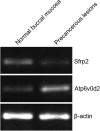Screen and analysis of key disease genes for precancerous lesions of oral buccal mucosa induced by DMBA in golden hamsters
- PMID: 22866075
- PMCID: PMC3410590
- DOI: 10.3892/ol.2010.228
Screen and analysis of key disease genes for precancerous lesions of oral buccal mucosa induced by DMBA in golden hamsters
Abstract
7,12-Dimethylbenz(a)-anthracene (DMBA)-induced oral buccal mucosa squamous cell carcinoma in Syrian golden hamsters was used to establish precancerous lesions. Agilent rat whole-genome microarray and biological information analysis were used to screen for genes related to key diseases during the transformation of normal buccal mucosa to precancerous lesions in golden hamsters. DMBA acetone solution (0.5%) was used to establish a model of precancerous lesions in oral buccal mucosa in golden hamsters. The results showed that a total of 1331 genes were differentially expressed, including 1278 known, 53 unknown, 747 up-regulated and 584 down-regulated genes. Analysis revealed a total of 14 gene interaction pathways that significantly associated with the 1278 known differentially expressed genes (P<0.05). In conclusion, the occurrence of precancerous lesions in the oral buccal mucosa of golden hamsters was caused by a number of genetic changes that resulted in changes to their respective pathways. Key candidate genes for the formation of precancerous lesions in oral buccal mucosa included Cyp2b13, Orc1L, casp8, CCL5, CXCL12, CCL20, Serping1, P518/Qrfp, F5, TFPI, Vcam1, Fn1, Angpt2, Lcp2, Cxadr, Lyn, Hck, Btk, RGD1564385/fes, Vav1 and IL5ra.
Figures


Similar articles
-
Screening the pathogenic genes and pathways related to DMBA (7,12-dimethylbenz[a]anthracene)-induced transformation of hamster oral mucosa from precancerous lesions to squamous cell carcinoma.Oncol Lett. 2011 Jul;2(4):637-642. doi: 10.3892/ol.2011.293. Epub 2011 Apr 26. Oncol Lett. 2011. PMID: 22848241 Free PMC article.
-
Screening and analysis of pathogenic genes during DMBA-induced buccal mucosa carcinogenesis in golden hamsters.Oncol Rep. 2010 Jun;23(6):1619-24. doi: 10.3892/or_00000803. Oncol Rep. 2010. PMID: 20428817
-
EMODIN EFFICACY ON THE AKT, MAPK, ERK AND DNMT EXPRESSION PATTERN DURING DMBA-INDUCED ORAL CARCINOMA IN GOLDEN SYRIAN HAMSTERS.Afr J Tradit Complement Altern Med. 2016 Sep 29;13(6):186-193. doi: 10.21010/ajtcam.v13i6.27. eCollection 2016. Afr J Tradit Complement Altern Med. 2016. PMID: 28480378 Free PMC article.
-
Role of the Chinese herbal medicine xianhuayin on the reversal of premalignant mucosal lesions in the golden hamster buccal pouch.Int J Oral Sci. 2010 Mar;2(1):53-8. doi: 10.4248/IJOS10013. Int J Oral Sci. 2010. PMID: 20690419 Free PMC article.
-
[Precancerous lesions of the buccal mucosa].Rev Stomatol Chir Maxillofac. 2001 Apr;102(2):77-108. Rev Stomatol Chir Maxillofac. 2001. PMID: 11446145 Review. French.
Cited by
-
New Gene Markers for Metabolic Processes and Homeostasis in Porcine Buccal Pouch Mucosa during Cells Long Term-Cultivation-A Primary Culture Approach.Int J Mol Sci. 2018 Mar 29;19(4):1027. doi: 10.3390/ijms19041027. Int J Mol Sci. 2018. PMID: 29596348 Free PMC article.
-
A nanoengineered topical transmucosal cisplatin delivery system induces anti-tumor response in animal models and patients with oral cancer.Nat Commun. 2022 Aug 17;13(1):4829. doi: 10.1038/s41467-022-31859-3. Nat Commun. 2022. PMID: 35977936 Free PMC article.
-
Novel Insights reveal Anti-microbial Gene Regulation of Piglet Intestine Immune in response to Clostridium perfringens Infection.Sci Rep. 2019 Feb 13;9(1):1963. doi: 10.1038/s41598-018-37898-5. Sci Rep. 2019. PMID: 30760749 Free PMC article.
-
The Arg-Phe-amide peptide 26RFa/glutamine RF-amide peptide and its receptor: IUPHAR Review 24.Br J Pharmacol. 2017 Oct;174(20):3573-3607. doi: 10.1111/bph.13907. Epub 2017 Sep 8. Br J Pharmacol. 2017. PMID: 28613414 Free PMC article. Review.
-
Angiogenesis and evading immune destruction are the main related transcriptomic characteristics to the invasive process of oral tongue cancer.Sci Rep. 2018 Jan 31;8(1):2007. doi: 10.1038/s41598-017-19010-5. Sci Rep. 2018. PMID: 29386520 Free PMC article.
References
-
- Kademani D, Bell RB, Schmidt BL, Blanchaert R, Fernandes R, Lambert P, Tucker WM. Oral and maxillofacial surgeons treating oral cancer: a preliminary report from the American Association of Oral and Maxillofacial Surgeons Task Force on Oral Cancer. J Oral Maxillofac Surg. 2008;66:2151–2157. - PubMed
-
- Bernier J, Cooper JS. Chemoradiation after surgery for high-risk head and neck cancer patients: how strong is the evidence? Oncologist. 2005;10:215–224. - PubMed
-
- Carinci F, Lo Muzio L, Piattelli A, et al. Genetic portrait of mild and severe lingual dysplasia. Oral Oncol. 2005;41:365–374. - PubMed
-
- Choi P, Chen C. Genetic expression profiles and biologic pathway alterations in head and neck squamous cell carcinoma. Cancer. 2005;104:1113–1128. - PubMed
-
- Shiu MN, Chen TH. Impact of betel quid, tobacco and alcohol on three-stage disease natural history of oral leukoplakia and cancer: implication for prevention of oral cancer. Eur J Cancer Prev. 2004;13:39–45. - PubMed
LinkOut - more resources
Full Text Sources
Miscellaneous
